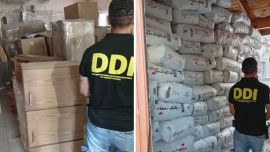The fight against organised crime in Latin America and the Caribbean is a pressing priority, not least because it is holding back economic growth, the World Bank warned on Monday.
The institution said in a report that it considers crime and violence to be “one of the most urgent problems in the region,” whose economy is forecast to grow by just 2.1 percent in 2025 and 2.4 percent in 2026 — making it the slowest-growing region globally.
For years, Latin America and the Caribbean have struggled with low annual economic growth, poor productivity, entrenched poverty, and high levels of inequality, said the World Bank. According to the report, the region “will remain trapped in this poor equilibrium” unless it succeeds in curbing organised crime and the violence that comes with it.
Homicide rates in South America, Central America, and the Caribbean “far exceed those observed in any other part of the world,” the World Bank noted.
Although the region is home to just nine percent of the world’s population, it accounts for roughly a third of global homicides. The disparity has grown: from an average homicide rate 5.4 times higher than the global figure (22.0 vs 4.1) in the first decade of the century, to eight times higher (23.9 vs 3.0) in the second.
However, the report notes that “Chile, Bolivia, Peru, and Argentina report lower homicide rates relative to their general levels of crime.”
From 2018 to 2022, national homicide rates ranged from 38 per 100,000 inhabitants in Honduras, to five in Argentina and four in Bolivia.Recent years have seen some improvement in countries such as El Salvador and Venezuela, while the situation has deteriorated in others, notably Ecuador and Haiti.
The World Bank called for both short- and long-term strategies. In the long term, it recommends improving education systems and labour markets. In the short term, however, it urges policymakers to prioritise the strategic strengthening of prison capacity, police forces, and justice systems. It also highlights the importance of prevention initiatives aimed at young people considered at risk of joining criminal groups.
In addition to these measures, the report underscores the need to build stronger state institutions — including courts, law enforcement agencies, and correctional facilities — as a foundation for sustainable crime reduction.
Moreover, the World Bank advocates for deeper regional cooperation among Latin American and Caribbean countries, encouraging governments to share best practices and coordinate efforts to tackle transnational criminal networks more effectively.
With no single cause behind the rise of organised crime in the region, the World Bank identified a range of contributing factors: surging global demand for cocaine, illegal gold, and migrant smuggling during the 2010s; the reorganisation of criminal groups in response to government crackdowns; the growing availability of firearms; increased diversification of criminal enterprises; and their expanding use of technology.
The Covid-19 pandemic further complicated matters. In countries such as Colombia and Mexico, it “enabled criminal organisations to gain legitimacy and power by providing social support and governance — at times replacing the state in areas of marked poverty and inequality,” the report notes.
In Venezuela, for example, the Tren de Aragua gang adapted to border closures during the pandemic by expanding its role from charging migrant transit fees to directly owning transport and accommodation businesses.
According to the latest estimates from the Inter-American Development Bank (IDB/BID), the direct costs of organised crime in Latin America and the Caribbean amounted to 3.4 percent of the region’s GDP in 2022.
– TIMES/AFP

























Comments